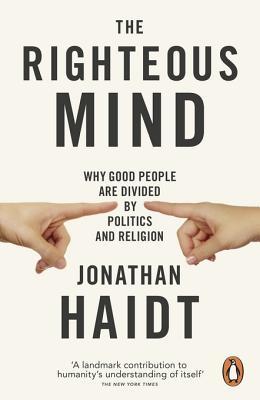More on this book
Community
Kindle Notes & Highlights
The hive switch is another way of stating Durkheim’s idea that we are Homo duplex; we live most of our lives in the ordinary (profane) world, but we achieve our greatest joys in those brief moments of transit to the s...
This highlight has been truncated due to consecutive passage length restrictions.
awe in nature, Durkheimian drugs, and raves.
Oxytocin bonds people to their groups,
Mirror neurons help people empathize
It would be nice to believe that we humans were designed to love everyone unconditionally. Nice, but rather unlikely from an evolutionary perspective. Parochial love—love within groups—amplified by similarity, a sense of shared fate, and the suppression of free riders, may be the most we can accomplish.
Religion Is a Team Sport
A college football game is a superb analogy for religion.
They focus on individuals and their supernatural beliefs, rather than on groups and their binding practices.
For Harris, beliefs are the key to understanding the psychology of religion
Believing, doing, and belonging are three complementary yet distinct aspects of religiosity,
The New Atheist model is based on the Platonic rationalist view of the mind,
To an evolutionist, religious behaviors “stand out like peacocks in a sunlit glade,” as Dennett put it.
hypersensitive agency detection device.
like the face detector, it’s on a hair trigger.
the birth of supernatural agents, not as an adaptation for anything but as a by-product of a cognitive module
“gullible learning” module:
circuitry for falling in love
The developmental psychologist Paul Bloom has shown that our minds were designed for dualism—we
The gods changed, however, and this brings us to the second step of the New Atheist story: cultural evolution.
race among the various supernatural concepts that people generated.
vast overpopulation of agent-ideas, most of which are too stupid to hold our attention for an instant;
religions are sets of memes that have undergone Darwinian selection.
Dennett proposes that religions survive because, like those parasites, they make their hosts do things that are bad for themselves (e.g., suicide bombing) but good for the parasite (e.g., Islam).
Just as a cold virus makes its host sneeze to spread itself, successful religions make their hosts expend precious resources to spread the “infection.”
an adaptation
Scott Atran and Joe Henrich
religions are sets of cultural innovations that spread to the extent that they make groups more cohesive and cooperative.
so their ideas (not their genes) spread.
As groups take up agriculture and grow larger, however, their gods become far more moralistic.
Creating gods who can see everything, and who hate cheaters and oath breakers, turns out to be a good way to reduce cheating and oath breaking.
When people believe that the gods might bring drought or pestilence on the whole village for the adultery of two people, you can bet that the villagers will be much more vigilant for—and gossipy about—any hint of an extramarital liaison.
Richard Sosis,
6 percent
secular communes
39 pe...
This highlight has been truncated due to consecutive passage length restrictions.
religious co...
This highlight has been truncated due to consecutive passage length restrictions.
the more sacrifice a commune demanded, the longer it lasted.
“To invest social conventions with sanctity is to hide their arbitrariness in a cloak of seeming necessity.”
Sacredness binds people together, and then blinds them to the arbitrariness of the practice.
But now that we know how quickly genetic evolution can occur, I find it hard to imagine that the genes stood still for more than 50,000 years.
How could the genetic partner in the “swirling waltz”36 of gene-culture coevolution not take a single step as the cultural partner began dancing to religious music?
fine-tuning of modules to make people more prone to adaptive forms of hiving, sacralizing, or godding, and less prone to self-destructive or group-destructive forms?
David Sloan Wilson,
Wilson’s great achievement was to merge the ideas of the two most important thinkers in the history of the social sciences: Darwin and Durkheim.
Darwin’s Cathedral,
Calvin developed a strict and demanding form of Christianity that suppressed free riding and facilitated trust and commerce in sixteenth-century Geneva.
how medieval Judaism created “cultural fortresses that kept outsiders out and insiders in.”
water temples among Balinese rice farmers
maypoles.
the central miracle of social life: e pluribus unum.


